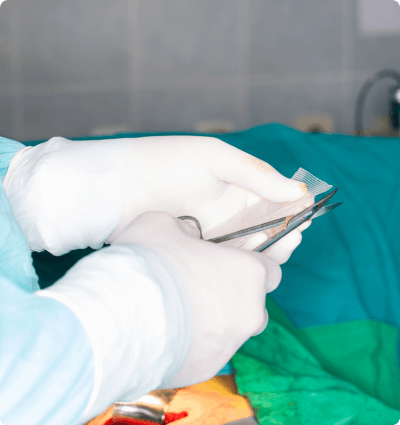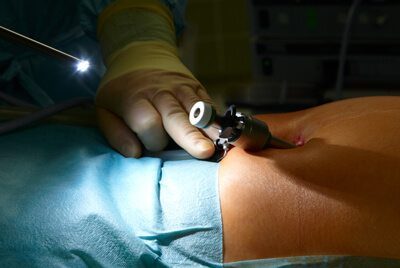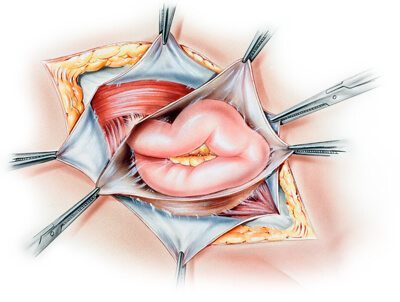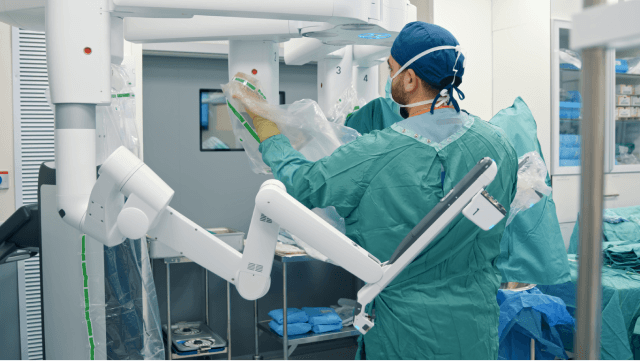Hernia Mesh Surgery
Hernia mesh surgery involves placing a device made from plastic or biological material to support the damaged hernia area. Recovery from hernia surgery with mesh typically takes four to six weeks. Hernia mesh revision surgery may be necessary to address subsequent pain, infection or mesh migration.
What Is Hernia Mesh Surgery?
Hernia mesh surgery is a procedure to correct tissue or organs protruding through a weak spot in the surrounding muscle or tissue. Surgeons use surgical mesh made from biological or synthetic materials to cover the gap. They attach this medical device with sutures or staples. Tissue then grows into the mesh to reinforce the muscle wall.
Doctors perform more than 700,000 surgeries for inguinal hernias annually in the United States. Surgery options with or without mesh depend on the size and location of the hernia. Most hernia surgeries in the United States use mesh, as this repair method can minimize recovery time and reduce recurrence.

Surgery is the only way to correct a hernia permanently. Before the use of hernia mesh, recurrence was the primary complication for patients. Medical literature consistently finds that mesh surgery reduces the likelihood of developing a hernia again.
Other factors can affect outcomes, such as the patient’s overall health, the surgical approach and the mesh type. Hernia mesh manufacturers have recalled certain kinds of mesh because of increased failure rates that led to complications and the need for hernia mesh revision surgery.
How Hernia Repair Surgery Using Hernia Mesh Works
Surgical mesh creates a flexible scaffold to prevent organs from pushing through muscle walls. General surgeons attach the mesh over the open hernia using sutures, adhesive or staples. Following the surgery, the patient’s tissue grows into the small holes of the device, strengthening the muscle wall.
Most mesh surgeries take anywhere from 30 minutes to two hours. Anesthesia type and operation time vary.
Many hernia operations use mesh reinforcements, regardless of surgery type. Mesh hernia repairs are usually permanent, meaning the device stays in the body.
These surgeries can prevent the condition from worsening and minimize the chance of recurrence. Hernia mesh surgery provides the only permanent solution for correcting a hernia.
Surgical Techniques and Types of Hernia Mesh Surgery
Technological advances have made way for new mesh-placement methods, such as enhanced-view totally extraperitoneal, endoscopic mini- or less-open sublay and endoscopic totally extraperitoneal approach.
- Intraperitoneal Onlay Mesh: Surgeons enter the peritoneal cavity to place mesh.
- Totally Extraperitoneal: Doctors place mesh from outside the peritoneum.
- Transabdominal Preperitoneal: Surgeons place mesh through a small incision in the peritoneum, a thin abdominal membrane.
Studies suggest that the TAPP method has higher rates of abdominal visceral injuries and port-site hernias. Surgeons consider TEP a more complex procedure but one with fewer potential complications.
Enhanced-view totally extraperitoneal surgical repair typically has a quicker recovery and less postoperative pain than IPOM, and a study indicates it can be more cost-effective. However, data also shows that IPOM is easier and faster than other laparoscopic hernia surgeries. Further study is needed to evaluate the differences.
Laparoscopic Surgery
Laparoscopic repair is a minimally invasive technique using small incisions, a telescope-like tool called a laparoscope, a camera and mesh. Typically conducted under general anesthesia, a surgeon makes incisions, then inserts and secures the mesh to cover the defect. Surgeons can also perform this technique without mesh.
Laparoscopic hernia surgery offers quicker recovery, smaller incision sites and less pain than open surgery. Doctors use this method for different hernia types, such as umbilical, inguinal, ventral or incisional. According to one scientific journal, “Laparoscopic surgery is the gold-standard surgical approach.”

The laparoscopic surgery technique has many benefits for the patient’s recovery. A study of the use of Progrip mesh for laparoscopic inguinal hernia repairs shows a hernia recurrence rate of 0.2%.
Open Repair Surgery
Surgeons can perform an open repair hernia surgery with or without surgical mesh. Doctors may use local anesthesia with sedation when using this method. A surgeon makes an incision over the hernia site, pushes the bulging parts into place and affixes mesh to the healthy surrounding tissue.
This procedure cuts through more muscle and requires a longer recovery than laparoscopic surgery. It can also increase the risk of blood loss, pain and infection. Open repair techniques are generally less expensive than laparoscopic approaches.

Surgeons commonly use open repair procedures to treat hernias. Making one long incision does increase the risks and recovery time. However, this approach enables doctors to place two mesh pieces on each side of the hernia, providing extra support to the weak muscle.
Robotic-Assisted Surgery
Robotic-assisted surgery is a newer technique using small incisions, a laparoscope and robotic surgical instruments. The surgeon controls the tools from a console in the operating room. This method provides 3D images of the defective area, offering doctors a more comprehensive view.

The instruments used in robotic hernia operations are smaller and easier to maneuver than other tools, allowing for better precision. This approach can cause less blood loss, reduced tissue damage and more nominal levels of pain. If hernia mesh revision surgery is necessary, both laparoscopic and robotic approaches are effective options.
What to Expect Before and After Hernia Surgery
Most hernia surgeries in the United States utilize the open repair method. Many patients go home on the same day as the procedure.
- The doctor assesses the patient’s health and medications.
- The anesthesiologist discusses options and gives preoperative instructions.
- The patient arranges for someone to take them to and from the surgery location.
- Hernia repair typically requires less than a 24-hour stay.
- Recovery from hernia surgery with mesh can take several days to weeks.
Patients often wonder if you can feel the mesh after hernia surgery. People will likely have tightness, pain and swelling near the mesh site. These issues should subside during recovery from hernia surgery with mesh. The patient should monitor symptoms and contact a doctor if symptoms are unusual or worsening.
How Much Do Hernia Surgeries Cost?
New Choice Health states that the average cost of a hernia repair in the United States is $7,750. Open repair generally costs less than laparoscopic hernia repair.
Prices vary depending on the patient’s insurance, the procedure type and the surgeon’s experience level. Inpatient procedures are significantly more expensive than outpatient surgeries. Prices also differ by location.
Serious Complications Can Result in Hernia Mesh Revision Surgery
Patients may encounter hernia mesh complications that require hernia mesh revision surgery to repair the damage.
- Bowel obstruction
- Hernia recurrence
- Infection
- Mesh adhering to internal organs
- Reactions to the mesh
- Severe pain
Some kinds of mesh do not hold up well. Mesh failure can cause nausea, vomiting, fever, pain, swelling, bruising and difficulty urinating or passing stool. Some patients have filed hernia mesh lawsuits after complications from failed mesh procedures.
Calling this number connects you with a Drugwatch.com representative. We will direct you to one of our trusted legal partners for a free case review.
Drugwatch.com's trusted legal partners support the organization's mission to keep people safe from dangerous drugs and medical devices. For more information, visit our partners page.


